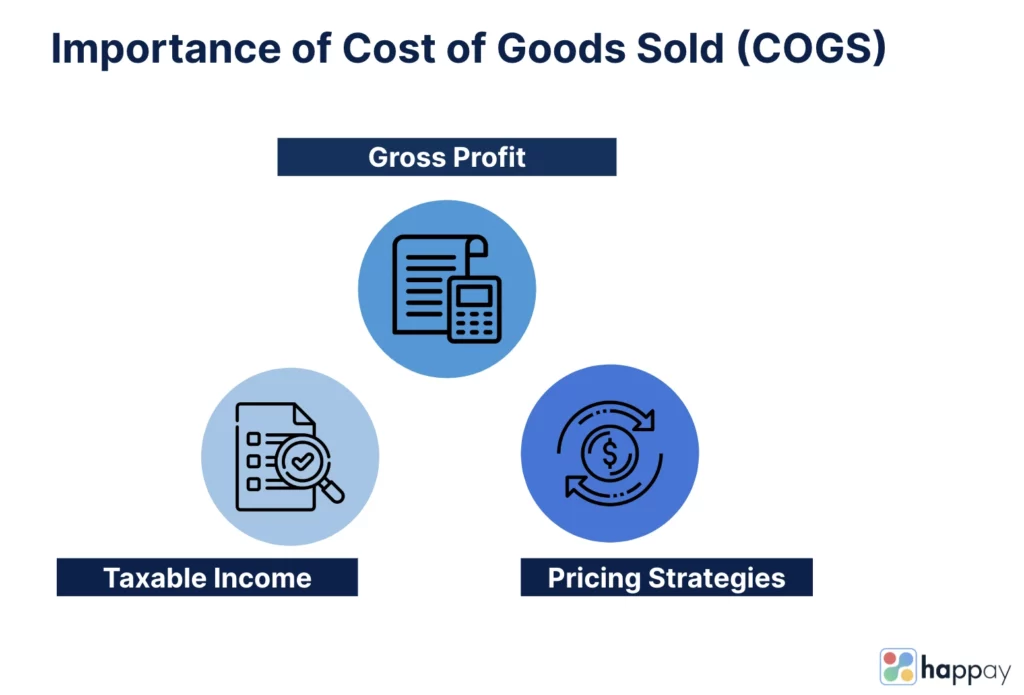Last Updated on November 28, 2025
Introduction
Measuring financial performance is crucial for any finance leader looking to improve efficiency and profitability in their organization. One of the ways they assess financial strength is by looking at the cost of goods sold (COGS) in financial statements.
COGS reveals an organization’s total direct costs of producing or procuring goods and services they sell during a financial period. This financial data enables CFOs to assess profitability, implement cost control measures, analyze gross profit margin, and develop accurate budget forecasts.
This article walks you through the meaning of the cost of goods sold in business finance, how to calculate COGS and report it in the income statement, and best practices for lowering COGS.
Must Read: Best Financial Management Tools for CFOs
What is the cost of goods sold (COGS)?
Cost of goods sold or cost of sales refers to the total direct costs that a company, distributor, manufacturer, or retailer incurs while producing goods and services sold. COGS includes direct labor, factory overheads, and raw material costs but excludes distribution and sales force costs.
The second line of an income statement shows the COGS as a business expense. Indian organizations following the Indian Accounting Standard (Ind AS) 2 must show the cost of finished goods inventory as an expense in their income statement. The U.S. Generally Accepted Accounting Principles require product organizations to calculate COGS using inventory costing principles.
COGS gradually increases when companies produce more goods to generate more revenue. Gross profit is the difference between revenue and COGS. Business finance leaders emphasize lowering COGS because it directly impacts the gross profit and gross margin.
Why is the cost of goods sold (COGS) important?
Businesses calculate the cost of goods sold to differentiate between direct and indirect costs and boost production efficiency.
Tracking COGS is also essential for:
- Making the right pricing decisions
- Calculating gross profit margin
- Availing tax deductions
Importance of cost of goods sold (COGS)

- Gross profit calculation: Businesses calculate gross profit by subtracting COGS from total revenue. Gross profit reveals how efficiently an organization manages its labor and production process. COGS directly impacts gross profit. As a result, higher COGS results in lower net income and vice versa. That’s why investors, managers, and analysts evaluate a company’s COGS to find profit estimates.
- Taxable income: The cost of goods sold is a deductible business expense, which can lower an organization’s taxable income. Enterprises and small businesses often show more eligible items in their COGS calculation to reduce the tax bill. However, they must keep records of manufacturing and inventory expenses that occur while producing goods or acquiring raw materials.
- Pricing decisions: COGS reflects an organization’s cost of doing business. It helps business managers and leaders estimate the correct product price and total revenue they need to cover the expenses. When a company sets lower prices than the COGS, they experience lower profit, thus leading to loss.
Now, let’s understand the different elements of COGS.
Read About: 10 Best Expense Management Software
What is included in the cost of goods sold?
The cost of goods sold includes any direct costs a business incurs while acquiring inventory or producing goods they sell. Direct costs are of two types: fixed and variable costs. Fixed costs include facility rent and factory overhead costs, while variable costs include raw materials and labor costs.
Businesses can understand the eligibility of a cost to be included in COGS by asking whether the cost will exist even if they didn’t produce any product. If the answer is no, they should include it in the COGS calculation.
Cost of goods sold examples include:
- Raw materials
- Storage costs
- Freight-in costs
- Production parts
- Factory labor cost
- Product containers
- Trade or cash discounts
- Items purchased for resale
- Purchase returns and allowances
- Finished products purchased from suppliers
- Storage and manufacturing facility rent costs
- Supplies or ingredients used as product components
- Factory overhead costs, including insurance, cleaning, electricity, and maintenance
It’s worth noting that the COGS calculation doesn’t consider the cost of inventory left in stock at the end of an accounting period. This cost becomes a part of the current asset on the balance sheet.
What does the cost of goods sold exclude?
The COGS excludes business expenses that aren’t directly related to producing or acquiring goods or services. Examples include administrative costs, management salaries, distribution, advertising, office rent, and accounting and legal fees. COGS also doesn’t include non-operating expenses such as interest and capital expenditures.
Service businesses and professionals, such as realtors, business advisors, accounting firms, and legal practices, don’t offer products or maintain stock. As a result, they don’t have COGS to show on the income statement. However, they can show the cost of services, which can’t be paired with COGS deduction.
Example of cost of goods sold
Imagine you want to calculate the COGS of a smartphone manufacturer, Abize Electronics Private Limited, for 2023.
The company’s inventory at the beginning and end of the calendar year was ₹ 15,75,000 and ₹ 2,25,000, respectively. They produced raw materials worth ₹ 5,75,000 during the calendar year.
Particulars |
Value |
|
Beginning inventory |
₹ 15,75,000 |
|
Raw material purchase |
₹ 5,75,000 |
|
Ending inventory |
₹ 2,25,000 |
Businesses typically calculate COGS by subtracting the ending inventory value from the sum of beginning inventory and raw material purchases during the calendar year.
Cost of goods sold = Beginning inventory + raw material purchase during the calendar year – ending inventory
Abize Electronics Private Limited’s COGS for 2023 is = ₹ 15,75,000 + ₹ 5,75,000 – ₹ 2,25,000 = ₹ 1925000
Cost of goods sold formula
Organizations calculate the COGS by subtracting the inventory value at the end of the accounting period from the sum of inventory value at the beginning and the cost of new merchandise purchased during the period.

COGS = Beginning inventory + inventory purchases – ending inventory
Let’s understand the different components of this formula.
- Beginning inventory refers to a company’s stock from the previous accounting period.
- Inventory purchases are an organization’s total costs while purchasing raw materials during the calendar year.
- Ending inventory is the remaining inventory at the end of a period.
Another way to calculate COGS is using the extended COGS formula, which considers freight charges, discounts, returns, and allowances.
COGS = (Beginning inventory + purchases + freight In) – (ending inventory + purchase discounts + purchase returns and allowances)
Different components of this formula are:
- Freight in refers to the company’s transportation costs for bringing raw materials to the factory.
- Purchase discounts are discounts an organization receives from the product supply chain vendors.
- Purchase returns are expenses incurred while returning items to suppliers.
- Allowances are additional benefits companies receive in the supply chain.
Learn About: 9 Best Vendor Payment Management Software
How to calculate the cost of goods sold?
Consider following the steps below to calculate the COGS.
- Determined direct and indirect costs: Start by finding your business’s costs while producing or buying goods or services.
- Calculate inventory: This step involves finding the total inventory value of your stock and the raw materials you’ll require to produce more goods. Also, consider the shipping charges and estimated value of damaged stock.
- Find inventory value: Now, it’s time to calculate the stock valuation using the inventory valuation method of your choice. Businesses typically use the last in, first out (LIFO), first in, first out (FIFO), or average cost method to calculate the inventory value.
- Calculate COGS: Finally, use all the data to calculate the COGS using the COGS formula.
Let’s look at how a business calculates COGS using the extended cost of goods sold formula.
From the example earlier, let’s calculate the COGS of Abize Electronics Private Limited based on the number of devices they sold in 2023. The direct cost of manufacturing each smartphone is ₹ 8,500.
They started with an opening inventory of 2,000 smartphones and ended the year with 15 devices. They also paid freight costs worth ₹ 2,00,000, purchase costs worth ₹ 6,50,000, and received discounts of ₹ 1,75,000.
The total cost of opening inventory is = 2,000 x ₹ 8,500 = ₹ 1,70,00,000
Their ending inventory cost is = 15 x ₹ 8,500 = ₹ 1,27,500
Abize Electronics Private Limited’s COGS is:
Beginning inventory + purchases + freight In – ending inventory – purchase discounts – purchase returns and allowances
= ₹ 1,70,00,000 + ₹ 6,50,000 + ₹ 2,00,000 – ₹ 1,75,000 – ₹ 1,27,500 = ₹ 1,75,47,500
How to report COGS in an income statement?
COGS appears in the second line item on an income statement after the sales revenue. It comprises all costs incurred while producing goods and services, including variable expenses like raw material and labor, and fixed costs like storage costs and factory overhead.

Source: Corporate Finance Institute
However, COGS doesn’t include general selling expenses, typically under the general and administrative (SG&A) expense section.
Accounting methods for cost of goods sold
International Financial Reporting Standards (IFRS) and US GAAP allow organizations to follow LIFO, FIFO, weighted average, and specific identification methods for COGS calculation. The Indian Accounting Standards (Ind AS) followed the guidelines set by the IFRS.
1. First in, first out (FIFO): The FIFO method enables organizations to sell goods they manufacture first. Companies using this method for inventory valuation show they are selling products with the lowest cost at first. As a result, they secure a higher profit margin but record lower COGS, lowering tax liabilities.
2. Last in, first out (LIFO): Using the LIFO method allows companies to sell the most recently produced items first when prices increase. As a result, they end up selling goods at higher prices, which increases the total COGS and lowers the net income.
3. Average cost: Organizations using this inventory valuation method average the cost of goods produced during an accounting period. Consequently, the COGS remains within a similar range and doesn’t fluctuate based on outliers.
4. Special identification: This method uses the exact price of each item to calculate the COGS for a period. Companies selling precious products like jewelry and cars prefer this method to find the cost of producing goods.
Quick Read: LIFO and FIFO Inventory Management: A Complete Guide
Cost of goods sold vs. operating expenses
The difference is that COGS reveals an organization’s direct costs of producing goods. In contrast, operating expenses (OpEx) include indirect selling, general, and administrative expenses for day-to-day business operations.
COGS is the total direct costs an organization must bear to produce or acquire goods and services they sell. Examples include raw material costs and labor costs. Organizations calculate COGS to evaluate profitability and change pricing strategies to meet overall expenses.
OpEx refers to indirect business expenses not tied to goods production but contribute to revenue generation. Examples include office supplies, marketing costs, insurance, rent, and employee salaries. Evaluating OpEx enables businesses to monitor and optimize day-to-day costs that can impact their bottom line.
Read More: Operating Expenses (OpEx) – Meaning, Types and Formula
Cost of revenue vs. COGS
The cost of revenue or cost of sales is an organization’s total direct cost of creating and delivering goods and services to customers. Organizations analyze the cost of revenue to understand the total operational costs of producing goods and services. Moreover, it’s also helpful for evaluating increasing input costs when revenue doesn’t change.
COGS is a company’s total direct and indirect costs of creating or acquiring products or services. Besides raw material and shipping costs, it includes warehouse, production equipment, and distribution costs.
Cost of revenue |
COGS |
|
|
Definition |
Refers to the total direct cost of creating products. |
Refers to the total direct and indirect cost of producing or procuring goods. |
|
Income statement |
Appears before the earnings before interest and taxes (EBIT) margin. |
Is listed after total sales revenue. |
|
Calculation |
Reflects the total number of goods an organization sells. |
Reveals the number of goods a company manufactures. |
|
Tax deduction |
Cost of revenue isn’t tax-deductible. |
COGS is tax deductible and may lower a company’s profit. |
How to analyze the cost of goods sold?
An organization’s cost of goods sold reflects its total production costs. Subtracting the COGS value from revenue gives them the gross profit. COGS also helps businesses calculate the value of other financial metrics, such as the COGS-to-revenue ratio and gross profit margin.
1. COGS-to-revenue ratio = COGS/revenue
COGS-to-revenue ratio provides organizations with production efficiency insights. A high ratio indicates that a company spends a significant portion of its revenue on production costs. This ratio enables companies to identify their cost structure, optimize prices to improve the bottom line, and make strategic procurement decisions.
2. Gross profit margin = Gross profit/revenue
Gross margin is one of the key profitability ratios enterprises measure to understand their financial health. It shows what an organization makes after paying the direct business expenses.
Companies with COGS of 50%-65% of sales are considered financially healthy. Otherwise, they may need to re-evaluate their business model or bookkeeping practices.
Learn About: TOP 10 Procurement Software Solutions
How does inventory affect COGS?
Overstated or understated inventory significantly impacts an organization’s COGS.
When companies overstate ending inventory than what’s available in stock, they show an excess stock on their accounting statement. As a result, they experience lower COGS. Similarly, understated inventory reduces ending inventory and increases the COGS.
Inventory discrepancies occur from stock receipt errors, unrecorded transactions, and administrative and reconciliation mistakes. That’s why organizations must correct these errors to make necessary inventory adjustments.
What types of companies don’t have COGS?
Service-based companies or pure service providers don’t have COGS. Examples include law offices, accounting service providers, realtors, dancers, and business consultants and advisers. These companies may spend money to offer services to customers but can’t show COGS on accounting statements. Instead, they show the cost of services.
Limitations of cost of goods sold
Factors that an accountant or manager can change to alter the COGS include:
- Overvaluation of in-hand inventory
- Failure to write off obsolete inventory
- Overstatement of manufacturer discounts and returns to suppliers
- High manufacturing overhead cost allocation than what incurred
- Changing the ending inventory amount left in stock at the end of a period
Business managers or accountants adopting fraudulent practices can easily manipulate an organization’s COGS on the income statement. For example, an overstated inventory results in under-reported COGS, leading to a higher gross profit margin.
To find these unscrupulous accounting practices, investors and analysts typically evaluate whether inventory grows faster than revenue or total assets.
Cost of goods sold best practices
Organizations looking to ensure accuracy in COGS accounting must follow the best practices below.

- Inventory valuation: Using an inventory valuation method consistently is crucial for accurately calculating the COGS during an accounting period.
- Physical inventory counts: Regular inventory checks enable organizations to compare physical counts to records and correct errors.
- Detailed record-keeping: Maintaining detailed inventory transaction records is essential for tracking COGS accurately.
- Inventory turnover monitoring: Organizations must also monitor the number of times they sell and replace inventory items. For example, a high inventory turnover can indicate accurate COGS. In contrast, a low turnover can result from an overstated inventory balance.
- Track additional expenses: Recording directly related costs, such as duties or freight, is crucial for accurately calculating the COGS.
- Use inventory management software: Inventory management tools streamline the process of tracking inventory-related transactions and calculating COGS. Organizations must use these systems to improve COGS accounting efficiency.
Quick Read: Best Inventory Management Software
Conclusion
Understanding COGS is essential for understanding an organization’s profitability and tax deductions. Calculating COGS also gives businesses valuable insights into whether they can optimize product prices or change vendors to increase gross margins. In a nutshell, COGS is essential to making informed decisions about production and driving profitability within business operations.
FAQs
COGS doesn’t include management salaries. However, it may consist of the labor costs of producing specific goods.
COGS is an organization’s total cost of producing goods and services sold. In contrast, the cost of sales is a company’s total cost of creating goods and services for purchase.
Production costs may refer to all direct costs or labor and material costs alone. COGS isn’t the same as production costs in both cases.
Ideally, the cost of goods sold can’t be negative. However, it can be negative when the opening inventory value and purchases are lower than the ending inventory value. Organizations can also experience negative COGS when they experience higher returns during a period or overstated cost correction from a previous period.
COGS includes inbound shipping costs or the cost of shipping from a vendor to a manufacturer. However, it excludes the cost of shipping to the consumer.
The cost of goods sold isn’t an asset or a tax liability. It’s an expense that organizations must pay to produce goods and services sold.








Discussion about this post